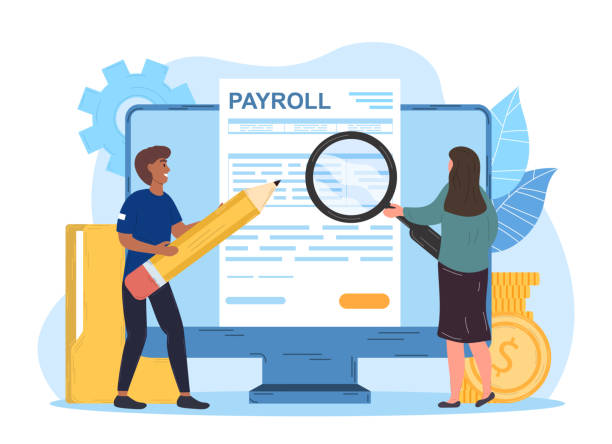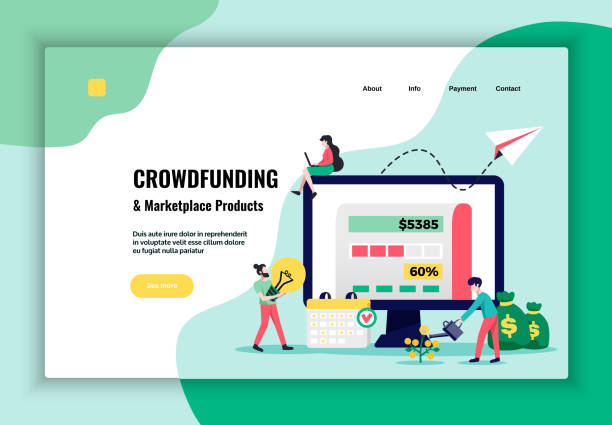Introduction: What is Responsive Web Design and Why is it Important?
![]()
In today’s world, where users access web content on a variety of devices such as smartphones, tablets, laptops, and even smart TVs, web design is no longer limited to displaying on a fixed size.
The concept of Responsive Web Design is the answer to this challenge.
This approach means building websites that can automatically and intelligently adapt their layout and elements to the size and resolution of the user’s device.
The main goal of #responsive_website_design is to provide a unified and optimized #user_experience, regardless of the device type.
This means a website should be as user-friendly on a mobile phone as it is on a large desktop monitor.
This adaptability is not only vital for user convenience but also plays a key role in #SEO and your website’s ranking in search engines.
This is an explanatory and comprehensive approach to beginning to understand the importance of this concept.
This technique, beyond a luxury option, has become an essential standard for any online business and is, in fact, responsive web design is the foundation for a successful presence in the digital age.
Is your e-commerce site ready to attract maximum customers and increase sales? Rasaweb transforms your online business with modern and efficient e-commerce website designs.
✅ Increased speed and improved SEO
✅ Excellent user experience on mobile and desktop⚡ Get a free consultation for e-commerce website design from Rasaweb!
Why Responsive Design is No Longer an Option, but a Necessity

In the not-so-distant past, having a separate website for mobile or even disregarding optimization for smaller devices was common.
But today, with the astonishing increase in mobile internet usage, this approach is no longer defensible.
According to global statistics, over half of web traffic comes from mobile devices.
This shift in user behavior has also forced search engines to change.
Google, as the largest search engine, has implemented a “mobile-first” policy in website indexing; meaning your website’s mobile version will be the basis for its ranking in search results.
Therefore, not having a responsive web design can directly affect your site’s SEO and lead to reduced traffic and loss of potential customers.
In addition to SEO, user experience (UX) is also a very important factor.
Imagine a user accessing your website from their mobile and having to constantly zoom and scroll to view content; this unpleasant experience quickly leads to a high bounce rate and the loss of that user.
A website with responsive web design automatically adjusts content to be easily viewable and interactive at any size, with buttons large enough and links easily tappable.
This not only reduces the bounce rate but also increases the user’s dwell time on the site and ultimately leads to a higher conversion rate.
This section is an in-depth analysis of why responsive design is a necessity and shows that this is an important analytical point in digital marketing strategy.
Fundamental Principles and Implementation Techniques of Responsive Design

Responsive web design is based on three key principles: Fluid Grids, Flexible Images, and Media Queries.
Fluid grids use relative units like percentages instead of fixed pixels to define column and row widths and heights.
This helps the layout maintain its scale as the screen size changes.
Flexible images, using CSS properties like `max-width: 100%`, ensure that images never overflow their container and scale up or down to fit the available space.
These two principles form the foundation of visual flexibility.
However, Media Queries are the heart of responsive web design.
These CSS rules allow developers to apply different style rules based on device characteristics, such as screen width, height, orientation (portrait or landscape), and even resolution.
For example, you can define that for screens less than 768 pixels wide, columns should stack vertically instead of side-by-side.
This specialized and educational section helps you gain a deeper understanding of how this system works.
In addition to these principles, concepts such as Mobile First Design (designing for mobile first and then scaling up for desktop) and the use of the Viewport Meta Tag (which tells the browser how to render the page on the device) are also crucial.
These techniques together provide the groundwork for a flawless user experience across all devices.
To better understand the differences, see the table below:
| Feature | Responsive Design | Adaptive Design | Separate Mobile Website |
|---|---|---|---|
| Number of Codebases | One single codebase | One codebase with multiple fixed layouts | Two separate codebases |
| How it changes | Continuously and fluidly with any screen size | Jumps between fixed layouts based on breakpoints | Redirects user to another address |
| Development Time | Medium to high (requires careful planning) | Medium | High (requires managing two projects) |
| Maintenance and Updates | Easy (one point for changes) | Medium | Difficult (requires applying changes in two places) |
| SEO Impact | Very good (Google’s recommendation) | Good | Challenging (duplicate content issues) |
The Impact of Responsive Web Design on SEO and Your Website’s Ranking

As mentioned earlier, responsive web design has a significant impact on SEO (Search Engine Optimization).
Google has explicitly stated that it recognizes responsive websites as the recommended method for mobile.
This is due to several key advantages: First, a single URL for all devices.
This helps Google index your content more easily and prevents duplicate content issues that occur with separate mobile websites.
Having a single URL also simplifies backlink management and social sharing, concentrating your SEO power in one place.
Second, reduced Bounce Rate and increased Dwell Time.
When users have a good experience on your website and don’t have to struggle to find content, they are more likely to stay on your site longer and view more pages.
These positive signals indicate to Google that your website is valuable to users and can lead to improved rankings in search results.
Third, page loading speed.
Although responsive web design itself does not guarantee site speed, modern tools and image/CSS/JavaScript optimization techniques typically employed alongside responsive design significantly help improve loading speed.
Site speed is an important ranking factor for Google and greatly affects user experience.
This section provides a practical guide and analysis for understanding the connection between responsiveness and SEO success.
Did you know that 94% of users’ first impressions of a business are related to its website design? With professional corporate website design by **Rasaweb**, turn this first impression into an opportunity for growth.
✅ Attract more customers and increase sales
✅ Build credibility and trust in the audience’s eyes⚡ Get a free website design consultation!
Common Challenges and Obstacles in Implementing Responsive Web Design

Despite its numerous advantages, implementing responsive web design can come with challenges.
One of the most important is content management across different sizes.
Sometimes, content that looks great on a desktop screen can become cluttered or unreadable on a small mobile screen.
Strategic thinking about content prioritization and how it should be displayed on different devices is crucial.
This is where the question arises: Should all desktop content be displayed on mobile?
The answer is often no.
It may be necessary to hide certain elements or completely change their layout.
Another challenge is related to performance issues.
If images are not properly optimized or CSS and JavaScript codes are too heavy, loading the website on mobile with slow internet can be extremely time-consuming.
This leads to a poor user experience and a high bounce rate.
Developers should consider techniques such as lazy loading for images, file compression, and minimizing HTTP requests.
Also, testing and debugging in different environments is difficult.
With the countless variety of devices, browsers, and operating systems, ensuring the website functions correctly on all of them can be time-consuming and complex.
This raises a questionable content point: How can we ensure full coverage of all scenarios?
Using emulator tools and actual testing on physical devices is essential.
Managing the complexities of CSS, JavaScript, and user interactions at different scales also requires high skill and experience to implement a responsive web design in the best possible way.
Effective Tools and Frameworks for Responsive Website Development

To facilitate and speed up the process of developing responsive web design, numerous tools and frameworks are available.
One of the most popular and well-known is Bootstrap.
This CSS/JavaScript framework provides a collection of predefined design templates, user interface components, and a robust grid system that helps developers quickly create responsive websites.
Bootstrap makes much of the developer’s work easier by offering responsive components such as navigation, forms, and buttons.
Another framework that takes a different approach is Foundation.
Like Bootstrap, this framework also offers a comprehensive set of tools for building responsive websites but generally provides more flexibility for customization and is favored by developers who need more control over the design.
Both frameworks, by providing fluid grid systems and pre-written media queries, make it much easier to achieve a responsive website design.
In addition to complete frameworks, native CSS technologies such as CSS Grid Layout and Flexbox are also powerful tools for creating complex and responsive layouts.
Flexbox is excellent for distributing and aligning items in one dimension (row or column), while CSS Grid is the best choice for two-dimensional layouts (both rows and columns) and gives unparalleled control over how elements are placed on the page.
These native CSS technologies give developers a lot of power and enable the creation of a unique responsive website without relying on heavy frameworks.
This is a purely educational section that refers to available tools.
Testing and Optimizing Responsive Websites for Superior Performance

After implementing responsive web design, the next crucial step is continuous testing and optimization.
Due to the vast array of devices and browsers, testing the website in different environments is essential.
Browser developer tools (such as Chrome DevTools) provide the ability to simulate different devices, which are very useful for initial testing and debugging.
However, using real devices is the best way to ensure a correct user experience.
Testing on Android phones, iPhones, tablets, and desktops of different sizes helps you identify display and performance issues that may not appear in simulators.
In addition to visual testing, performance testing is also extremely important.
Tools such as Google PageSpeed Insights and Lighthouse (also available within Chrome DevTools) can provide detailed reports on your website’s loading speed, SEO, development best practices, and accessibility.
These tools offer suggestions for improvement such as image optimization, minification of CSS and JavaScript files, enabling Gzip compression, and using browser caching.
Optimizing for Google’s Core Web Vitals is also highly recommended.
These critical metrics, such as LCP (Largest Contentful Paint), FID (First Input Delay), and CLS (Cumulative Layout Shift) directly impact user experience and SEO ranking.
A responsive web design is not just about looking good, but also about flawless performance.
This is a specialized and practical guide.
| Tool | Primary Use | Advantages |
|---|---|---|
| Chrome DevTools (Device Mode) | Simulating various devices, responsive testing | Free, in-browser, extensive debugging features |
| Google PageSpeed Insights | Speed and performance analysis, optimization suggestions | Based on real user data, important factor for SEO |
| Google Lighthouse | Comprehensive check of performance, SEO, accessibility, and best practices | Detailed reports with scoring, usable as a command-line tool |
| BrowserStack / LambdaTest | Testing on real browsers and devices in the cloud | Broad coverage of devices and browsers, simultaneous testing |
| GTmetrix | Website speed and performance analysis | Visual and easy-to-understand reports, optimization suggestions |
The Future of Responsive Web Design and Emerging Trends

The web landscape is rapidly evolving, and responsive web design is no exception.
Emerging trends indicate that the future of this field is moving towards increasingly personalized and intelligent user experiences.
One of the most important of these trends is Progressive Web Apps (PWAs).
PWAs are websites that offer native app capabilities, such as offline functionality, push notifications, and installation on the device’s home screen, without the need to download from app stores.
This approach blurs the line between website and application and allows a website with responsive design to provide a richer, more native-like app experience.
Other important trends include the use of AI and machine learning in the design process and content personalization.
For example, tools that can display different content or dynamically adjust the layout based on user behavior on a specific device.
Responsive web design with Dark Mode is also gaining popularity, allowing users to switch between light and dark themes and personalize their visual experience.
This feature is especially important on mobile devices and for reducing eye strain in low-light environments.
Furthermore, an increasing emphasis on speed and performance is expected.
With the advent of 5G and rising user expectations, websites must load in a fraction of a second.
This requires deeper optimizations in images, fonts, and code.
The future of mobile-friendly design will move towards experiences that not only look great on any device but also intelligently interact with the user and their environment, delivering unparalleled performance.
This information is a news update about the future of the web.
Do you dream of a thriving online store but don’t know where to start?
Rasaweb is your comprehensive e-commerce website design solution.
✅ Attractive and user-friendly design
✅ Increased sales and revenue⚡ Get a free consultation
Successful Examples of Responsive Design and Lessons to Learn

Examining successful examples of websites that have well-implemented responsive web design can be inspiring and entertaining, teaching us valuable lessons.
Many large brands and reputable global media outlets have been pioneers in this field.
For example, websites like The New York Times, Apple, and Airbnb are prominent examples of excellent responsive design.
These websites not only perform well across different screen sizes but also provide a consistent user experience across all devices.
What lessons can we learn from these examples? First, simplicity and clarity in design.
Successful websites organize information in a way that is easily understandable even on the smallest screens.
They use simple navigation and clear hierarchies to help users find what they are looking for.
Second, focus on performance.
These websites load very quickly, even on slow internet connections.
They use optimized images, clean code, and caching techniques to deliver the best possible performance.
Third, interactivity and accessibility.
These websites ensure that all interactive elements such as buttons and links are easily clickable or tappable and accessible to users with special needs.
This means adhering to Web Accessibility Standards.
Reviewing these points provides a precise analysis of success factors in responsive web design and shows that simply resizing is not enough; all aspects of user experience must be considered.
Summary and Next Steps for a Future-Proof Website

Throughout this article, we have explored the indispensable importance of responsive web design in today’s digital landscape.
From its necessity in the mobile era and its positive effects on SEO to its technical principles, challenges, tools, and future trends, all indicate that responsive design is no longer an optional feature, but a fundamental pillar for any successful website.
A responsive website not only improves user experience and increases conversion rates but also helps you achieve a better ranking in search engines and ultimately reach a wider audience.
If your website is not yet responsive, the next steps are clear: First, conduct a comprehensive assessment of your website’s current status.
Is it optimized for mobile? How is its loading speed? Then, consult with an experienced development team to formulate a comprehensive strategy for transforming your website into a responsive platform.
This process may involve a complete redesign or gradual optimizations.
In any case, investing in responsive web design is an investment in the future of your business.
Remember that your website is the showcase of your business in the online world.
Ensuring that this showcase is displayed in the best possible way on every device is not just a technical action but a strategic decision for long-term success.
By adhering to principles and utilizing appropriate tools, you can create a powerful responsive web design that not only meets today’s needs but is also prepared for future challenges.
This is the final explanation and guidance for moving towards a future-ready website.
Frequently Asked Questions
| Question | Answer |
|---|---|
| What is Responsive Web Design? | It’s a method for designing websites that optimizes the appearance and functionality of the website according to the screen size of the user’s device (mobile, tablet, laptop, etc.). |
| Why is responsive design important? | Due to the increased use of various devices for internet access, responsive design provides a better user experience, improves site SEO, and reduces maintenance costs. |
| What are the most important responsive design tools? | Media Queries in CSS, use of relative units (such as percentage, em, rem, vw, vh), Flexible Images, and Grid Systems. |
| What role do Media Queries play in responsive design? | Media Queries allow the application of different CSS styles based on device characteristics (such as screen width, height, orientation, and screen type). |
| What is the Mobile First concept in responsive design? | It is an approach where design and development begin first for the smallest screen (mobile) and then gradually expand for larger screens (tablet, desktop). |
| Does responsive design affect site SEO? | Yes, Google prefers responsive websites because they offer a better user experience and eliminate the need for separate mobile and desktop versions, which helps improve SEO ranking. |
| What does Fluid Layout mean? | It means that the width of page elements is defined using relative units (such as percentages) instead of fixed pixel values, so they automatically adjust with changes in screen size. |
| How are Flexible Images used in responsive design? | By setting the `max-width: 100%;` property for images in CSS, it is ensured that the image never exceeds its container and its scale is maintained with changes in screen size. |
| What are the differences between responsive design and adaptive design? | Responsive design uses a single layout that fluidly adapts to any screen size, while adaptive design uses several fixed, predefined layouts for specific screen sizes. |
| Are CSS frameworks like Bootstrap useful in responsive design? | Yes, frameworks like Bootstrap have a responsive Grid System and pre-designed components that make the process of building responsive websites much simpler and faster. |
And other services of Rasaweb Advertising Agency in the field of advertising
Smart Conversion Rate Optimization: A fast and efficient solution for digital branding with a focus on SEO-driven content strategy.
Smart UI/UX: A fast and efficient solution for customer acquisition with a focus on attractive user interface design.
Smart Sales Automation: A novel service for increasing sales through dedicated programming.
Smart Marketing Automation: A fast and efficient solution for analyzing customer behavior with a focus on Google Ads management.
Smart UI/UX: A novel service for increasing online growth through marketing automation.
And over hundreds of other services in the field of internet advertising, advertising consultation, and organizational solutions
Internet Advertising | Advertising Strategy | Sponsored Articles
Resources
Complete Guide to Responsive DesignHow Responsive Design Works?Advantages of Having a Responsive WebsiteThe Importance of Responsive Design in Today’s Web
? Are you ready for your business to be seen in the online world? Rasaweb Afarin Digital Marketing Agency, with years of experience and expertise in the digital field, is with you to turn your dreams into reality. We help you attract more audiences and experience sustainable growth by providing innovative and creative solutions, including fast and optimized website design, professional SEO, social media management, and targeted advertising. With Rasaweb Afarin, the future of your business begins today.
📍 Tehran, Mirdamad Street, next to Bank Markazi, Kazerun Jonoubi Alley, Ramin Alley, No. 6


